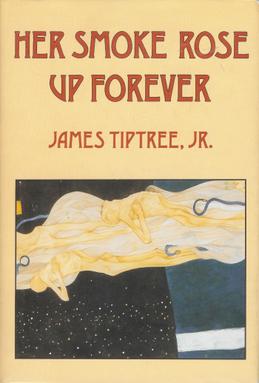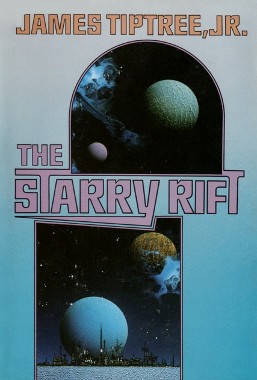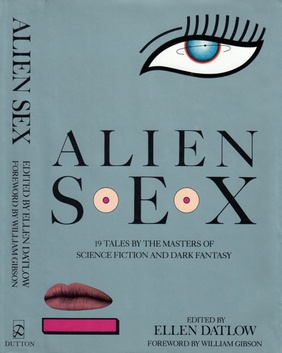
Alice Bradley Sheldon was an American science fiction and fantasy author better known as James Tiptree Jr., a pen name she used from 1967 until her death. It was not publicly known until 1977 that James Tiptree Jr. was a woman. From 1974 to 1985 she also occasionally used the pen name Raccoona Sheldon. Tiptree was inducted into the Science Fiction Hall of Fame in 2012.
The Otherwise Award, originally known as the James Tiptree Jr. Award, is an American annual literary prize for works of science fiction or fantasy that expand or explore one's understanding of gender. It was initiated in February 1991 by science fiction authors Pat Murphy and Karen Joy Fowler, subsequent to a discussion at WisCon.

John Joseph Vincent Kessel is an American author of science fiction and fantasy. He is a prolific short story writer, and the author of four solo novels, Good News From Outer Space (1989), Corrupting Dr. Nice (1997), The Moon and the Other (2017), and Pride and Prometheus (2018), and one novel, Freedom Beach (1985) in collaboration with his friend James Patrick Kelly. Kessel is married to author Therese Anne Fowler.

Nalo Hopkinson is a Jamaican-born Canadian speculative fiction writer and editor. Her novels – Brown Girl in the Ring (1998), Midnight Robber (2000), The Salt Roads (2003), The New Moon's Arms (2007) – and short stories such as those in her collection Skin Folk (2001) often draw on Caribbean history and language, and its traditions of oral and written storytelling.

Patrice Ann "Pat" Murphy is an American science writer and author of science fiction and fantasy novels.

Houston, Houston, Do You Read? is a novella by James Tiptree Jr.. It won a Nebula Award for Best Novella and a Hugo Award for Best Novella in 1977.
"Love Is the Plan the Plan Is Death" is a short story by James Tiptree, Jr., a pen name used by American writer Alice Sheldon. The novella won a Nebula Award for Best Short Story in 1974. It first appeared in the anthology The Alien Condition, edited by Stephen Goldin, published by Ballantine Books in April 1973.

Suzy McKee Charnas was an American novelist and short story writer, writing primarily in the genres of science fiction and fantasy. She won several awards for her fiction, including the Hugo Award, the Nebula Award and the James Tiptree Jr. Award. A selection of her short fiction was collected in Stagestruck Vampires and Other Phantasms in 2004. The Holdfast Chronicles, a four-volume story written over the course of almost thirty years was considered to be her major accomplishment in writing. The series addressed the topics of feminist dystopia, separatist societies, war, and reintegration. Another of her major works, The Vampire Tapestry, has been adapted into a play called "Vampire Dreams".

Camouflage is a 2004 science fiction novel by American writer Joe Haldeman. It won the James Tiptree, Jr. Award in 2004 and the Nebula Award for Best Novel in 2005.

Crown of Stars is a posthumous collection by American writer James Tiptree, Jr., containing unpublished short stories and those published in the final years of her career. All but one of the stories had previously been published elsewhere, in Science fiction magazines or anthologies. It is copyrighted to “the Estate of Alice B. Sheldon” and was first published in 1988 by Tom Doherty Associates. Crown of Stars is 340 pages in length and contains ten short stories.

Warm Worlds and Otherwise is a short story collection by American writer Alice Sheldon, first published in 1975 under her pen name James Tiptree Jr. In its introduction, "Who is Tiptree, What is He?", fellow science fiction author Robert Silverberg wrote that he found the theory that Tiptree was female "absurd", and that the author of these stories could only be a man. After Sheldon wrote him that Tiptree was a pseudonym she assumed, Silverberg added a postscript to his introduction in the second edition of the book, published in 1979. According to David Pringle, the collection contains:
Twelve furiously imaginative, occasionally explosive SF stories, the best of which are quite brilliant

Karen Joy Fowler is an American author of science fiction, fantasy, and literary fiction. Her work often centers on the nineteenth century, the lives of women, and alienation.

Kelley Eskridge is an American writer of fiction, non-fiction and screenplays. Her work is generally regarded as speculative fiction and is associated with the more literary edge of the category, as well as with the category of slipstream fiction.

Her Smoke Rose Up Forever is a collection of science fiction and fantasy stories by author James Tiptree, Jr. It was released in 1990 by Arkham House. It was originally published in an edition of 4,108 copies and was the author's second book published by Arkham House. It was later released to a wider audience in paperback form in 2004 from Tachyon Publications.
"When It Changed" is a science fiction short story by American writer Joanna Russ. It was first published in the anthology Again, Dangerous Visions.

The Starry Rift is a linked science fiction short story collection by James Tiptree, Jr first published in 1986 by Tor Books. It takes place in the same universe as several other works by Tiptree, most notably her 1985 novel Brightness Falls from the Air.

"And I Awoke and Found Me Here on the Cold Hill's Side" is a science fiction short story by American author James Tiptree, Jr. Originally published in The Magazine of Fantasy & Science Fiction, the short story has been republished in several anthologies.
Biological warfare (BW)—also known as bacteriological warfare, or germ warfare—has had a presence in popular culture for over 100 years. Public interest in it became intense during the Cold War, especially the 1960s and '70s, and continues unabated. This article comprises a list of popular culture works referencing BW or bioterrorism, but not those pertaining to natural, or unintentional, epidemics.

Nebula Award Stories 9 is an anthology of award winning science fiction short works edited by Kate Wilhelm. It was first published in the United Kingdom in hardcover by Gollancz in November 1974. The first American edition was published by Harper & Row in January 1975. Paperback editions followed from Corgi Books in the U.K. in November 1976, and Bantam Books in the U.S. in July 1978. The American editions bore the variant title Nebula Award Stories Nine. The book has also been published in German.

Aurora: Beyond Equality is an anthology of feminist science fiction edited by Vonda N. McIntyre and Susan Janice Anderson and published in 1976.
















